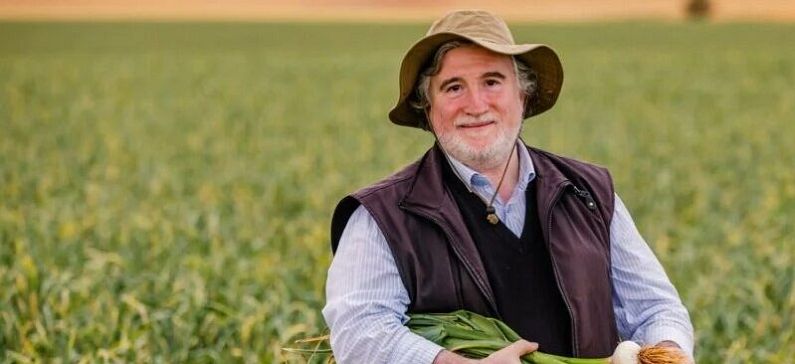
The King of… garlic is Greek
“No matter what stone you lift, you will meet a Greek”, said the wistful people and once again, it is confirmed. Greeks of the diaspora continue to excel, regardless of age and speciality. The 58-year-old Nikos Diamantopoulos, who can be described as the “King of Garlic”, is a tremendous example.
“Garlic has been a superfood for 5,000 years and in itself,” he declares, while he also makes a fortune from the garlic varieties he grows, which he supplies to Australia. And with his activity, he has halved the import of Chinese garlic. Something he had intended to do all along.
He is a brilliant scientist who has used his knowledge and his brain by choosing to be active in something different and unusual. Formerly a pharmacist, he is now the largest garlic trader in the ‘land of kangaroos’, with the motto ‘garlic’s unique healing properties’.
“As a child, I wanted to be a builder one day, a landowner, a farmer the next. My mother was into gardening, so I grew up in nature,” he tells the popular Australian expatriate newspaper New World. Experimenting with the fruits of the earth, he ended up combining science with his passion and focused on garlic and its hundreds of varieties. “I wanted to get into farming, to be in business in this sector, but without sabotaging other producers, taking a share of the existing ‘pie’,” he notes, explaining that he did the necessary research and found that no one in Australia had focused on garlic farming “95% of the garlic available on the market was imported from overseas,” he points out.
But every beginning is a difficult one and, as he explains, the problem he faced in his start-up was that the seeds he found in Australia were contaminated. “I was convinced I would succeed, and that’s because I was a pioneer. There was no way I was going to let the opportunity go to waste, given that Australia was dependent on importers, in this area Australia seemed helpless,” he explains. Then, Nikos Diamantopoulos and his team asked experts from the Pete Doherty Institute to test different varieties of garlic, including their properties, only to find out that it protects against both type A flu and coronavirus!
“It was difficult to develop garlic farming in Australia. That was exactly the challenge, the gamble for me. I started with experiments in my own laboratory,” he says, describing his friction with the subject in his 25 years of activity.
Travelling from Victoria to Syria, and even to the peaks of the Andes, he managed to find and grow garlic varieties suitable for Australia. “I found 296, but most were not suited to Australia’s climate. In fact, I was excited by the Peruvian ones: I discovered varieties that had been the same and unchanged for 500 years; they had been around since the Spanish conquistadors had brought them – and ‘launched’ them – in Latin America,” he continues.
He notes that the variety that made the greatest impression on him came from Senegal. A tropical variety, which 25 years ago no one could have imagined that it would become the first cultivated variety in Australia. After all, it’s a country with a huge area, which makes it harder to grow what you want where you want. “And yet,” he points out, “this one has proved to be very hardy – both in the cold south and in the heat in the northern volcanic part of the country, near Ballarat. The challenge from the beginning was to discover varieties that grow in different climates, from the tropical north to the cold south.
Nikos Diamantopoulos leaves nothing to chance. He oversees everything on his plantation, which supplies 1,500 tonnes and eight varieties to the Australian market, accounting for 80% of garlic production in the land of kangaroos. Thanks to his mobilisation, imports have been significantly reduced by about half. Of course, even with these figures, it does not mean that it is working with all the major food chains.
His financial success is enormous, but he considers himself a winner because he is in a position to supply most of Australia with his products, but also because, as he says, ‘foreign garlic and especially Chinese bulbs have – to a large extent – left the supermarket shelves. Because, by experimenting with the product, I learned that if you heat it above 56°C, it loses its properties. So I suggest to everyone, having now personal experience, to put a little bit of fresh garlic in their daily meals. Raw though. If you use it for health reasons – traditionally, this is the case for hypertensives – don’t cook it.”
Most people who follow trends in haute cuisine are aware of the rich flavor of black garlic, while other varieties are better for health. “I don’t consider it an antidote to viruses. “I don’t think it’s an antidote to viruses. However, if you’re going to use it, get a variety that has been lab-tested, like ours. A variety that, proven, will do you good,” he says.
His plantation, located six hours from Melbourne, is in Miltura, in northwest Victoria. “Sunny and with rich soil, it was ideal for us to set up our farm and facilities there,” says Diamantopoulos.
“Garlic has been a superfood for 5,000 years and on its own,” he adds, and concludes: “It doesn’t even need processing. The ancient Greeks used wild garlic to treat various ailments. They even offered it as a gift to the gods. The Romans did the same afterwards. During the great cholera epidemic – in the 18th century in Europe – the French ate garlic to avoid catching it, as did the Americans in 1918, when the Spanish flu plagued the continent. This ancient ‘remedy’ remains to this day. Having managed to supply half of Australia, we feel very good.”







